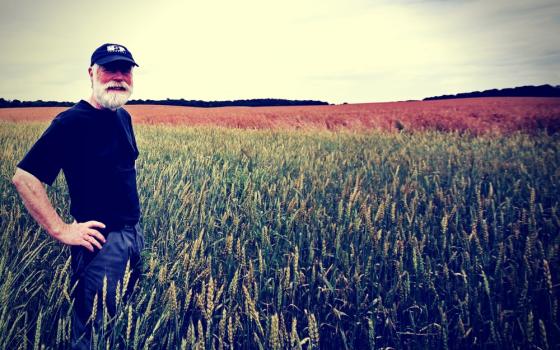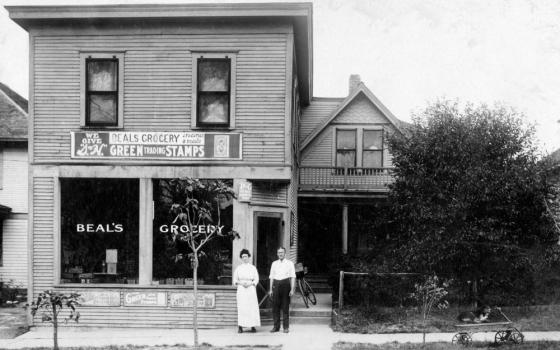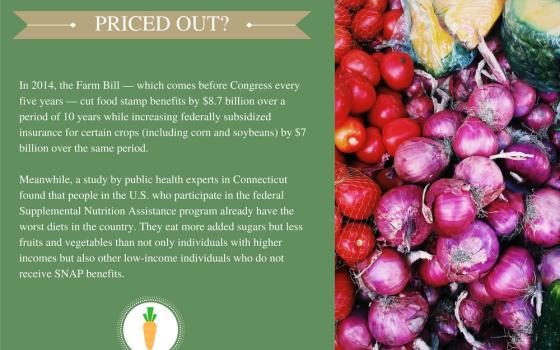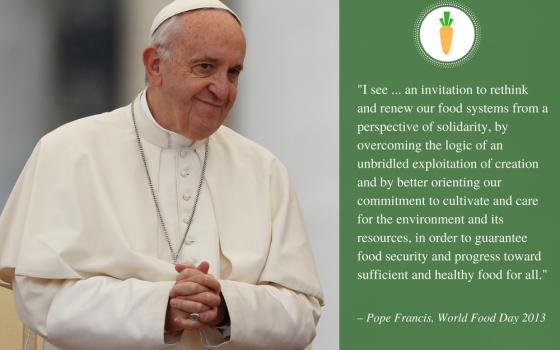Editor's Note: Global Sisters Report often focuses on work that sisters do to help those who are hungry or have food insecurity. This week, as the United States celebrates the feast of Thanksgiving, we focus on sisters who are active in food justice — trying to make sure that everyone not only has enough to eat but also access to healthy choices.
______
Single mother Cindy Shipley works as a dog groomer in New Palestine, Indiana. She makes about $1,200 a month, and her income is supplemented by the disability benefits she and her two teenage children receive. After paying her rent and bills, Shipley has about $500 left over each month to feed a household that can be as big as seven people when she watches her two grandchildren — which she does several times a week.
The U.S. Department of Agriculture estimates that a family of four must spend at least $568 a month to eat a balanced diet. And so, when Shipley goes to the grocery store, she has to be strategic.
On the first of the month, Shipley goes to the popular discount grocer Aldi to stock up on things like Ramen noodles, frozen chicken nuggets, lunchmeat and spaghetti. She makes another shopping trip at the end of every week, spending about $50 to grab whatever she needs to complement her dinner plans. She tries to do most of her shopping at Aldi because of the low prices. However, one Friday night in November, Shipley bypassed Aldi to pick up a few items at a local supermarket chain. She was disappointed. "There wasn't a lot in the cart for $60," she said.
The dilemmas that Shipley and other low-income consumers in the United States face when they buy food is one result of a transformed U.S. food system that has largely left low-income people behind, said Ursuline Sr. Christine Pratt who has been studying U.S. food and agriculture for the last 40 years. The rallying cry of people like Pratt, who are part of the food justice movement, has been that all people should have the right to grow, sell and eat healthy foods.
While an estimated 42 million people in the U.S. aren't sure where their next meal is coming from, hunger is not the country's only food issue. So is food sovereignty — the ability to choose how the foods one eats are produced, traded and consumed.
In the last decade or so, more attention has been focused on food production. Books like Fast Food Nation and The Omnivore's Dilemma have become New York Times bestsellers, and in 2010, the documentary Food Inc. was nominated for an Academy Award. This year, critics are hailing a new documentary, Seed, which looks at how just a few corporations control what crops are planted.
The result has been a resurgent interest by many people in the U.S. in the source of their food. There's been a proliferation of new health food stores and farm-to-table restaurants, and organic produce and products are increasingly popular. But these alternatives to the conventional food market are largely out of reach for people like Shipley.
For starters, many low-income people don't live close to any kind of grocery store, let alone a niche health food market. The U.S. Department of Agriculture reports that 29.7 million people (all of them in communities where 40 percent of the population lives below the poverty line) live in food deserts — neighborhoods at least a mile away from a grocery store.
Shipley has a car, which gives her some options when she shops. But for households without a car or reliable access to public transportation, that can mean being stuck buying food from whatever's available within walking distance — likely fast-food restaurants or convenience and dollar stores that may or may not have fresh produce for sale.
Furthermore, even when healthy foods are readily available, they can still be cost prohibitive. A 2013 study sponsored by the Harvard School of Public Health found that eating a diet rich in fruits, vegetables, fish and nuts costs about $550 more per year per person than eating a less healthy diet. Junk foods are cheap because they are cheap to make — yet eating a habitually poor diet has its own set of costs, including obesity, heart disease and certain cancers. Diet-related health care costs the United States more than $390 billion a year, according to the Harvard study.
Even people like Shipley who go out of their way to buy fresh produce — she says she makes a salad three to four times a week, for the vitamins — can be priced out of the foods they would really like to eat. In her ideal world, Shipley said she would buy organic produce because she believes it's "grown healthier." But buying organic just doesn't make sense for her budget.
"It's super expensive," Shipley said. "A bag of organic carrots is $3, and I don't even think it's a pound. But you can get a 3-pound bag of baby carrots that are peeled, washed — the whole nine yards — for $2.99. So you get way more for your money."
The issue, many food justice advocates say, is that a handful of large corporations control not only what foods appear in grocery stores but how much they cost. A 2013 Oxfam study singled out 10 food and beverage companies as essentially controlling what the world eats: Associated British Foods, Coca-Cola, Danone, General Mills, Kellogg, Mars, Mondelez International, Nestlé, PepsiCo and Unilever.
That's quite a leap from just a few generations ago when small, diversified local farms fed the U.S. population.
To Pratt, the fact that low-income households like Shipley's are constricted in their access to certain foods and certain stores is a moral failing of the modern food system. "It all funnels right back down to who controls food, who controls the land and who eats and does not eat as a result of that," she said.
Who controls the food, who controls the land
Today, most of the agricultural production in the U.S. happens at just a small number of large-scale farms; in fact, the most recent USDA census found that the largest 4 percent of farms controlled 55 percent of all U.S. farmland. In turn, these farms are supplied by just a sprinkling of biotech companies.
Patented Monsanto seeds, for example, are responsible for 80 percent of the corn grown in the U.S. and for more than 90 percent of the soybeans. These crops are then sold either directly to food companies like those on Oxfam's so-called Big 10 list or to a similarly limited number of crop processors.
"If you just look to see who are the big players in crop processing, it's the same players over and over," said Robert Gronski policy coordinator for the advocacy group Catholic Rural Life. "It's Cargill, it's ADM [Archer Daniels Midland]. And if you look at livestock production, it's Cargill again. So it's not quite a monopoly, but it's an oligopoly, and that affects to a great extent the type of food that comes to market."
Thanks in part to lobbying efforts by international food corporations, the federal government has been offering farmers subsidies for corn and soybeans since the 1970s — which, perhaps unsurprisingly, is what most farmers are now growing. In fact, last year, 44 percent of the money farmers made came from corn and soybeans, most of which was not grown for direct human consumption, but rather to feed livestock or to make ethanol and cheap sweeteners like high fructose corn syrup.
"You go out the countryside, and it's just full of corn or soybeans," Gronksi said with a laugh. "And people there still have to go to the store to find the food they're going to eat. They can't just eat the raw corn, of course."
Stewards and caretakers
Neither Gronksi nor Pratt are critical of farmers. Quite the opposite. When Pratt served as the rural life director for the Diocese of Toledo, Ohio — a role she had for 25 years — she says one of her primary goals was to address the immediate needs of farmers in the area. For his part, Gronski is currently working with national farmers unions on a project exploring the spiritual vocation of agricultural leaders.
What Gronski and Pratt are against, however, is the food production system to which U.S. farmers find themselves beholden — a system they say is not only responsible for pricing certain foods out of the reach of people like Shipley, but that also is bad for the farmers themselves.
In order to meet the demands of multinational corporations, Pratt said, small farmers face enormous pressure to grow their operations and to produce more. "And it's oftentimes to the detriment of the farmer who can't afford to do that," she said.
She saw this trend when she worked with farmers in Toledo, some of whom spent millions building up their farms only to lose the land in foreclosure. This year, it's reported that farmer debt levels are the highest they've been in 30 years. Furthermore, many farmers who rented land in the last several years to expand their operations are now struggling to repay their loans.
"Eating is moral act with spiritual, social, economic and political implications," Pratt said. "The Earth belongs to God, and were are merely stewards and caretakers, so we have a lot of work to do in terms of how food is produced and the effect that has on future generations."
Gronksi says he no problem holding the big agribusiness corporations responsible for the current state of affairs, although he does so with a caveat.
"Now, it's not so much that you can point to Monsanto or Cargill or ADM and say, 'You're the ones at fault,'" he said. "The thing to try to hold together is that they're just responding to what the market has dictated, but they're certainly taking advantage of the situation."
And that's an economic policy, Gronksi says, that is almost fundamentally at odds with Catholicism.
"The Catholic faith in general has always been, I'd say, somewhat critical of a capitalist economic system that's only gain is to produce capital," he said. "There's something called the preferential option for the poor, and the first thing we should all be doing is trying to raise up the impoverished. No one should be living in those conditions, so we've got to address that first. When it comes to food justice, that means everyone's getting a proper diet."
In Pratt's world, food justice also means reestablishing the relationship between food consumers and producers.
"The relationship between the grower and consumer is gone in this system where we go to the grocery store. People have no idea where their food comes from. There might be a sign that says it comes from Peru or Mexico, but the real thought of what that means and how it's produced are missing," she said. "That's why I think you'll find that a lot of women religious, especially as they change their land over, are trying in a small way to produce food locally and help others produce food locally."
[Dawn Araujo-Hawkins is a Global Sisters Report staff writer, based in Kansas City, Missouri. Follow her on Twitter @dawn_cherie]
Food justice, part two - Sisters take action to increase access to nutrition





